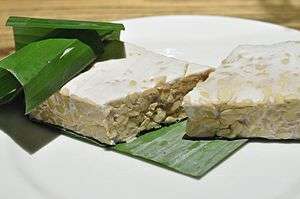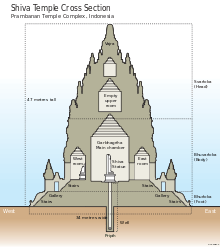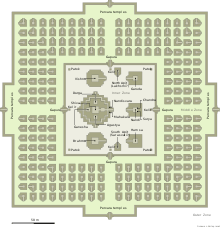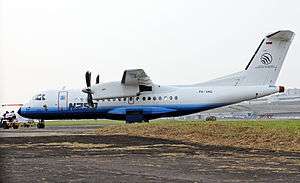List of Indonesian inventions and discoveries
This list of Indonesian inventions and discoveries details the indigenous arts and techniques, cultural inventions, scientific discoveries and contributions of the people of Indonesian archipelago — both ancient and modern state of Indonesia.
Since ancient times, native Indonesians has accumulated knowledge and developed technology stemmed from necessities; from naval navigation knowledge, traditional shipbuilding technology, textile techniques, food processing to vernacular house building. Notable examples include pinisi, perahu, Borobudur ship and sandeq vessels. In textile production, batik, ikat and songket were developed extensively by Indonesians. Living in tropical hot and humid environs, Indonesians also has developed the knowledge on food processing technology, especially fermentation, owed to the abundance of mold and fungi species in the region. Notable example includes tempeh, oncom, tuak, brem and tapai. In traditional art and entertainment, Indonesians has developed wayang kulit shadow theatre, various dance drama also gamelan orchestra.
The scientific pursuit, technical improvement and technological innovation are continuously developed to this day, among other by institution such as Indonesian Institute of Sciences. Indonesia has a number of industries that producing various advanced technology tools and vehicles; from shipbuilding to weaponry, armoured car to aeroplane. Today, Indonesia has developed their own aviation technology, with the development of CN-235, N-219 and N-250.
Arts and entertainment
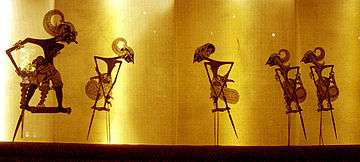
- Wayang, a form of traditional puppet theatre found in Indonesia.[1] Variants including wayang kulit shadow play and wayang golek.
- Wayang orang, a type of classical Javanese dance drama theatrical performance with themes taken from episodes of the Ramayana or Mahabharata.[2]
- Topeng, Indonesian mask dance-drama in which one or more mask-wearing, ornately costumed performers interpret traditional narratives concerning fabled kings, heroes and myths, accompanied by gamelan music.
- Barong, Balinese lion dance, Barong is a lion-like creature and character in the mythology of Bali. The battle between Barong and Rangda is featured in Barong dance to represent the eternal battle between good and evil.[3]
- Ondel-ondel, a large Betawi puppet folk performance, is about 2.5 meters tall with ± 80 cm diameter, made of woven bamboo where human can fit into it. The word ondel-ondel refers to both the performance and the puppet.
- Javanese dance, the dances and art forms that were created and influenced by Javanese culture.[4]
- Balinese dance, an ancient dance tradition that is part of the religious and artistic expression among the Balinese people of Bali. Balinese dance is dynamic, angular and intensely expressive.[4]
- Kecak, a form of Balinese dance and music drama that was developed in the 1930s in Bali. Formed as a coordinated chants and arm movements.[5]
- Saman, a intricately choreographed dance of thousand hands of Gayo ethnic group, Aceh.[6]
- Ketoprak, a theatrical genre of Java featuring actors who may also sing to the accompaniment of the gamelan. It draws its stories from Javanese history and romances, invented as recent as 1923.[7]
- Sandiwara, a genre of traditional theatrical drama of Indonesia. In general, it refer to any kinds of drama or theatrical performances, and literally sandiwara means "to pretend" or "to act". However, the term is often used to describe a genre of traditional drama of West Java, with notable example include the once famous Sandiwara Miss Tjitjih.[8]
Music
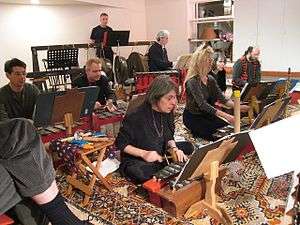
- Gamelan, the traditional ensemble music native to Java and Bali made up predominantly of percussive instruments, especially metallophones.[9]
- Angklung, the bamboo musical instrument made by attaching bamboo tubes into bamboo frame and shake it to create the sound, native to Sundanese of West Java.[10]
- Kolintang, an ancient instrumental form of music composed on a row of small, horizontally laid gongs, especially prevalent in the Eastern Malay Archipelago—the Southern Philippines, Eastern Indonesia (North Sulawesi, Maluku, East Nusa Tenggara), Eastern Malaysia, Brunei and Timor,[11]
- Keroncong, is the name of a ukulele-like instrument and also refer to a genre of Indonesian musical style. It was derived from Portuguese influence on colonial Indonesia.[12]
- Langgam Jawa, a regional form of Indonesian kroncong music most often associated with the city of Surakarta (Solo). Langgam jawa utilizes a variety of non-native instruments, such as the flute, guitar, ukulele, cello and violin. However, these instruments are performed using a seven-tone Javanese gamelan scale known as pelog. The song mostly performed in Javanese.
- Campursari, a crossover of several contemporary Indonesian music genres, mainly Javanese Langgam Jawa and Dangdut.
- Dangdut, a popular genre of Indonesian folk and traditional popular music that was influenced by Hindustani, Malay, and Arabic music.[13]
- Pop Indo, Indonesian pop music.
- Rock Indo, rock music from Indonesia.
Game

- Congklak, a mancala game played in Indonesia, Malaysia and Philippines. Although the origin is obscure, the oldest tradition of similar game can be traced to Javanese dakon with pitmarked stones from the bronze-Iron Age period of Indonesia.
- Galasin, or galah asin or gobak sodor, traditional Indonesian games.
- Surakarta (game), an Indonesian strategy board game for two players, named after the ancient city of Surakarta in central Java. The game features an unusual method of capture which is unique and not known in any other board game".[14][15]
- DreadOut, Indonesian psychological survival horror video game developed by Digital Happiness and published by PT Digital Semantika Indonesia and directed by Vadi Vanadi, featuring Indonesian horror, demons and mythical creatures.
Clothing and fashion

- Batik, is a technique of wax-resist dyeing applied to whole cloth, often uses canting as a tool to apply liquid hot wax to create motifs. Although similar wax-resist technique are found in several countries, the batik of Indonesia, however, may be the best-known.[16]
- Songket, is a hand-woven in silk or cotton, and intricately patterned with gold or silver threads. Indonesia perhaps has the richest tradition of this brocade weaving art.[17]
- Ikat, is a dyeing technique used to pattern textiles that employs resist dyeing on the yarns prior to dyeing and weaving the fabric. The ikat tradition is especially prevalent in Central and Eastern Indonesia, especially in Sumba, Flores and Timor island.
- Tapis, a traditional weaving style from Lampung, Indonesia. The word tapis also refers to the resulting cloth. It consists of a striped, naturally-coloured cloth embroidered with warped and couched gold thread.
- Ulos, a traditionally hand-woven cotton fabrics, and intricately patterned, specific to Batak tribes of North Sumatra usually slung over the shoulder during traditional occasions.
- Kebaya, a traditional blouse-dress, the national costume of Indonesia, although it is more accurately endemic to the Javanese, Sundanese and Balinese peoples.[18]
- Sarong, a large tube or length of fabric, often wrapped around the waist.
- Peci, a cap widely worn in Indonesia, Malaysia and Brunei, mostly among Muslim males. in Indonesia the peci can also be associated with the nationalist secular movement.[19]
- Indonesian traditional men headgears, various traditional Indonesian hats, headgears or headdress wore by Indonesian men in traditional settings. Notable examples include Javanese blangkon, Sundanese iket, Acehnese kupiah, Malay tanjak, Balinese udeng, and Dayak beluko.
Construction and civil engineering
- Rumah adat, various indigenous technique of carpentry, wood carving and stone masonry employed in constructing traditional houses of vernacular Indonesian architecture. Notable example includes tongkonan, rumah gadang, omo sebua, joglo and pura.
- Candi, stone temple architecture developed in ancient Java circa 7th or 8th century. It employs an intricate system of interlocked stone masonry, knobs, indentations and dovetails, and corbelling method.[20]
- Sosrobahu, a road and bridge construction technique which twist the concrete beam shoulder of the supporting pylon, which allows long stretches of flyovers to be constructed above existing main roads with a minimum of disruption to the traffic, designed by Tjokorda Raka Sukawati.[21]
- Cakar ayam construction, or literally means "chicken claw construction" is a technical engineering to create a more stable foundation by employing concrete plate supported by pipes planted deep into the ground acted as "claws", invented by Prof. Dr. Ir. Sedijatmo in 1961. The technique is applied on structures, roads and runways. The technical principle consist of a concrete plate foundation is supported and secured to the ground by pipes as "claws", which allowed a more stable construction, enable to build structure on soft wet ground such as on swamps. The technique allowed the structure to be more rigid, stable and more durable against uneven weight distribution or uneven land declining.[22]
Economy

- Arisan, a form of Rotating Savings and Credit Association in Indonesian culture, a form of Microfinance.[23]
- Piggy bank, known as celengan[n 1] in Indonesian, it is a boar-shaped terracotta figurine with a slit hole used to insert, collect and store coins. Despite piggy bank was probably a result of parallel development in several places around the world, one of the oldest manifestation of pig-shaped money box is dated from Majapahit period, in Java circa 14th century.[24]
- Warung, a type of small Indonesian family-owned business — often a casual shop, a modest small restaurant or café.[25] There are many kinds of warung, some take the form of a small shop that sells cold bottled drinks, candy, cigarettes, snacks, kue, krupuk and other daily necessities, while the larger ones are small restaurant establishments.
Food processing and cuisine

- Tempeh, fermented soybean cake made by growing whitish Rhizopus oligosporus fungi. The fermentation technique is native to Java.[26][27]
- Oncom, fermented by-product of soybean or peanuts tailings (tofu dregs), which growing mold of Rhizopus oligosporus or Neurospora intermedia var. oncomensis.[28] The fermentation technique is native to West Java.
- Tapai, fermented sweet and sour tasting food usually made either from rice or cassava, commonly found in Indonesia.[29]
- Rendang, slow cooked spicy meat dish, usually beef cooked with complex mixture of spices and coconut milk. Specialty of Minangkabau ethnic group of West Sumatra. The spices, garlic, shallot, ginger, and galangal used in rendang have antimicrobial properties and serve as natural organic preservatives.[30]
- Pindang, Indonesian traditional method to preserve food by boiling the ingredients in salt together with certain spices that contains tannin.[31]
- Bumbu, Indonesian blend of spices and it commonly appears in the names of spice mixtures, sauces and seasoning pastes.[32]
- Brem, traditional Indonesian fermented food or fermented beverage. There are two types of brem, brem cake (solid) that is usually eaten as snack from Madiun and Wonogiri,[33] and brem beverage (liquid) made of rice wine from Bali. Brem appeared in Java circa 1000 CE.[34]
- Tuak, traditional alcoholic beverage made from the sap of various species of palm tree such as the palmyra, date palms and coconut palms.
- Kue, Indonesian bite-sized snack or dessert food. Kue is a fairly broad term in Indonesian to describe a wide variety of snacks; cakes, cookies, fritters, pies, scones, and patisserie.[35]
- Sambal, Indonesian hot and spicy sauce typically made from a mixture of a variety of chili peppers with secondary ingredients such as shrimp paste, tomato, garlic, ginger, shallot, scallion, palm sugar and lime juice. It is an essential condiment in Indonesian cuisine.
- Sweet soy sauce, Indonesian sweetened aromatic soy sauce, which has a dark colour, a thick syrupy molasses-like consistency due to the generous addition of palm sugar.[36]
- Various iced dessert, various dessert recipe of shaved ice with fruits, coconut milk and palm sugar. Notable example include cendol, es teler, es campur, es doger and es kelapa muda.
- Coconut rice, various recipes of rice cooked with coconut. Notable example include nasi uduk, nasi liwet, nasi gurih, burasa, nasi kuning and tumpeng.
- Banana leaf cooking, cooking methods employing package of banana leaf or coconut fronds. Specific recipes including pepes, botok, lemper, lontong and ketupat.
- Dry instant noodle, although ramen instant noodle were developed and invented by Japanese, Indonesian invented its dry or soupless version, Indomie Mi goreng, which omit its soup and mixed with vegetable oil and Indonesian sweet soy sauce.
- Teh botol, bottled sweetened jasmine tea drink served cold, introduced in Indonesia in the 1970s.
Literature

- Indonesian scripts, various indigenous or foreign derivation of script, writing systems and alphabet traditions developed in Indonesian archipelago. Notable examples include Kawi script, Javanese script, Balinese alphabet, Sundanese alphabet, Rencong alphabet, Batak alphabet, Rejang script, Lontara alphabet and Jawi alphabet.
- La Galigo, an epic creation myth of the Bugis from South Sulawesi.[37]
- Kakawin, a tradition of Kawi Old Javanese poetic literature, mostly developed in Medang Mataram, Kediri, to Majapahit period circa 10th to 15th century Java. Notable examples include Kakawin Ramayana, Kakawin Bhāratayuddha, Kakawin Arjunawiwaha, Kakawin Hariwangsa and Kakawin Sutasoma.
- Panji, a compilation of tales about a legendary 12th century prince of East Java. His life formed the basis of a cycle of Javanese stories, that are the basis of various poems and a genre of wayang and topeng masked dance. Panji tales have spread from East Java to be a fertile source for literature and drama throughout Southeast Asia, including Indonesia, Malaysia, Thailand and Cambodia.
- Nagarakretagama, also known as Desawarnana, is an Old Javanese eulogy to Hayam Wuruk, a Javanese king of the Majapahit Empire. It was written on lontar as a kakawin by Mpu Prapanca in 1365 (1287 Saka year).[38]
- Pararaton, also known as the Book of Kings, is a Javanese chronicle[39]:187 in the Kawi language. The comparatively short text of 32 folio-size pages (1126 lines) contains the history of the kings of Singhasari and Majapahit in eastern Java.
- Bujangga Manik, an Old Sundanese literature dated from circa late 15th century to early 16th century.[40] It is a travelogue of Prince Jaya Pakuan alias Bujangga Manik, throughout Java and Bali. He was a Sundanese Hindu rishi, though a prince at the court of Pakuan Pajajaran.
- Siksakanda ng Karesian, literally the title means the book of rules with guidance to be a resi (wise or holy man). A Sundanese didactic manuscript dated from the early 16th century, mostly contains moral and spiritual lessons in Hindu Sundanese tradition.
- Serat Centhini, a compilation of Javanese tales and teachings, written in verse and published in 1814, commissioned by Crown Prince Mangkunegoro (later enthroned as Pakubuwono V of Surakarta).[41][42]
- Dongeng, Indonesian folklore, a collection of Indonesian traditional tales, folklore and legends that used to teach morality for children. Notable example includes Lutung Kasarung, Bawang Merah Bawang Putih, Leungli, Sangkuriang, Timun Mas, Roro Jonggrang, Kancil Story and Malin Kundang.
Medicine, health and biology

- Jamu, Indonesian traditional herbal medicine indigenous to Java.[43]
- Lulur, Javanese topical herbal lotion applied upon skin believed to enhance smoothness and beauty. Today, it is commonly practiced and offered as one of spa treatment in Indonesia.
- Kerokan, is a traditional Javanese medical treatment in which the skin is scraped to produce red-colored light bruising. Practitioners believe kerokan releases unhealthy elements from injured areas and stimulates blood flow and healing. It is believed that the practice derived from Chinese Gua sha.
- Puskesmas, (Indonesian: Pusat Kesehatan Masyarakat) are government-mandated community health clinics located across Indonesia. It improves the health quality of common Indonesian people by extend the reach of health service, promoting hygiene and sanitation, family planning, maternal health on childbirth, also infants immunization.
- Info-Bidan, information technology for Indonesian midwives via SMS. This information technology is devised to assist bidan (midwives) during childbirth to avoid maternal mortality.[44]
Philosophy, ideology, politics and social sciences

- Pancasila, the official, foundational philosophical theory of the Indonesian state.[45] This pluralist political stance was meant as a compromise to provide the moderate middleground among ideological-political spectrums — between leftist socialist and rightist nationalist religious (esp. Islamic element).
- Marhaenism, a socialistic political ideology developed by the first President of Indonesia, Sukarno.[46]
- Nasakom, a political concept during the Sukarno presidency in Indonesia. It is an acronym based on the Indonesian words NASionalisme ('nationalism'), Agama ('religion'), and KOMunisme ('communism').[47][48]
- Gotong royong, or "working together", a concept of indigenous communal work derived from traditional Indonesian community.
- Islam Nusantara, a distinctive brand of empirical Islam developed in Nusantara (Indonesian archipelago) since the 16th century. The main traits of Islam Nusantara are tawasut (moderate), rahmah (compassionate), anti-radical, inclusive and tolerant. Islam Nusantara is a result of interaction, contextualization, indigenization, interpretation and vernacularization of universal Islamic values, according to socio-cultural reality of Indonesia. The term was proposed and promoted by Indonesian Islamic organization Nahdlatul Ulama, as an alternative for interpretation on global Islam that mainly dominated by Arabic or Middle Eastern perspectives.[49]
- Shiva-Buddha, a syncretic Hindu-Buddhist religious doctrine developed in ancient Java during the Singhasari and Majapahit period (13th to 15th century). The doctrine advocate for the oneness of dharma and promote religious tolerance between Shivaist and Buddhist in ancient Java. Notable literary work including Sutasoma, written by Tantular circa late 14th century. The Candi Jawi is an example of Shiva-Buddha syncretic temple.[50]
Sports
- Pencak Silat, a class of related traditional Indonesian martial arts.[51] It is a full-body fighting form incorporating strikes, grappling and throwing in addition to weaponry. Every part of the body is used and subject to attack. Pencak silat was practiced not only for physical defense but also for psychological ends.[52]
- Tarung Derajat, a full body contact hybrid martial art from West Java, Indonesia, created by Haji Achmad Dradjat.[53] He developed the techniques through his experience as a street fighter during the 1960s in Bandung. Tarung Derajat is officially recognized as a national sport and used as a basic martial art training for the Indonesian Armed Forces and Indonesian National Police.
- Sepak takraw, kick rattan ball sport native to Southeast Asia.[54] Started as traditional game, today sepak takraw has been developed as competitive sport, shared with Malaysia and Thailand.
- Karapan sapi, chariot-like bull race, a native tradition in Madura island, East Java.[55]
Technology, information, physics
- SolsticeX, a global technology group, founded by an Indonesian in 1997.
- GO-JEK, an Indonesian hyperlocal transport, logistics and payments startup founded in 2010.
- Tokopedia, Indonesia’s biggest online marketplaces startup, launched in 2009.
- Dual Fast Fourier transform applied in 4G LTE technology, discovered by Khoirul Anwar.[56]
- Abbreviated Epitaxial Growth Mode (AGM), method for reducing cost and improving quality of LEDs and lasers, patented by Nelson Tansu.[57]
- Motorcycle portable refrigerator, a cooling system to refrigerate the transported seafood using the exhaust gas from motorcycle tailpipe. The amonia from the exhaust and water fueled a generator which vaporize the chemical and separate it from the water molecules. The ammonia is then channeled to a condenser, where the vapor will turn into liquid, and flows into an evaporator. The mixture of ammonia and water vapor to produce the cooling solution for the system.[58]
- Gel-coated helmet or cooling helmet, a helmet that gives cool sensation to the wearer’s head using gel chemical. The helmet interior is layered with heat insulation material. Invented by a young Indonesian student, Linus Nara Pradhana.[59]
- Bioplastic cassava, a biodegradable plastics made from cassava starch. Invented by Avani Eco startup based in Bali.[60][61]
Transportation
- Tanja sail, a type of sail commonly used by Malay and Austronesian peoples.
- Junk rig, invention of Malay people several hundred B.C.E., adopted by the Chinese as their main type of sail.
- Lug sail, a type of sail
- Pinisi, a traditional Indonesian two-masted sailing ship used widely by the Buginese and Makassarese, mostly for inter-insular transportation, cargo and fishing purposes within Indonesian archipelago.[62]
- Perahu, a type of traditional multihull sailboat with outrigger, and is most numerous in the various islands of Indonesia.
- Sandeq, a traditional Indonesian sailing ship with outrigger and triangular sail, used widely by the Mandar of West Sulawesi, mostly for fishing.
- Junk, Asian sailing ship that used widely in Asia. Although it is associated with China, Pierre-Yves Manguin, points to a probable Old Javanese origin.[63]
- Javanese Junk, a large type of junk particularly made in Java and Kalimantan.
- Penjajap, fast rowing and sailing-type ship from Nusantara.[64]
- Kora-kora, a type of oared ship used prominently in the western part of the archipelago.
- Kakap, small pirate boat that's usually act as scout for Penjajap.
- Lancaran, a type of galley-like vessel commonly used in Sumatra and Java.
- Borobudur ship, the 8th-century wooden double outrigger, sailed vessel of Maritime Southeast Asia depicted in some bas reliefs of the Borobudur Buddhist monument in Central Java, Indonesia.[65]
- CN-235, a medium-range twin-engined transport aircraft that was jointly developed by Construcciones Aeronáuticas SA (CASA) of Spain and Indonesian manufacturer IPTN, as a regional airliner and military transport.
- NC-212, a turboprop-powered STOL medium transport aircraft designed and built by CASA in Spain for civil and military use. C-212s are also produced under licence in Indonesia by Indonesian Aerospace (IAe), formerly called IPTN.
- N-219, a twin-engine, 19-seater transport aircraft designed by Indonesian Aerospace for multi-purpose missions in remote areas.[66]
- N-250, a regional aircraft commuter turboprop, an original design by the Indonesian firm IPTN (Industri Pesawat Terbang Nusantara/now Indonesian Aerospace).
Weapons and military

- Kris, asymmetrical wavy blade indigenous to Indonesia, especially Java island. It has distinctive blade-patterning achieved through alternating laminations of iron and nickelous iron (pamor).[67]
- Karambit, a small Indonesian curved knife resembling a claw. In Indonesia mostly associated with Silek Minangkabau (West Sumatran Silat).[68]
- Golok, a blade similar to a machete, that comes in many variations and is found throughout the Indonesian archipelago.[69]
- Kujang, a blade weapon native to the Sundanese people of western Java.
- Parang, a type of machete or cleaver used across Indonesian archipelago.
- Celurit, a sickle with a pronounced crescent-blade patterns which curves more than half a circle and a long handle, is widely used for agricultural purposes and also in Pencak Silat.
- Cetbang, a type of bronze breech-loading cannon produced and used by Majapahit Empire (1296-1520 CE) and other kingdoms in Nusantaran archipelago.[70]
- Lantaka, a type of bronze swivel gun mounted on merchant vessels travelling the waterways of Malay Archipelago. Its use was greatest in precolonial Southeast Asia especially in Indonesia, Malaysia, Brunei and the Philippines.
- Pindad SPR, a series of sniper rifle produced by PT. Pindad, Indonesia.
- Stun shoes, electroshock weapon in the guise of woman's shoes invented by Hibar Syahrul Gafur. Electric shock were delivered through a kick. It was meant as a self-defense tool for women against violence or sexual attack.[71]
- Anoa armoured personnel carrier, a 6x6 armoured personnel carrier developed by PT Pindad of Indonesia.[72]
- Wulung military drone, a military drone made by PT Dirgantara Indonesia.[73]
Miscellaneous
- Subak, the paddy fields irrigation system of Bali, which includes water temples, rice terraces, and a whole ecological and socio-cultural aspects of traditional Balinese agricultural community.[74]
- Kretek, is an aromatic cigarette made with a blend of tobacco, cloves and other flavors. This Indonesian cigarette was developed in 19th century Central Java. The word "kretek" itself is an onomatopoetic term for the crackling sound of burning cloves.[75]
- Penile insertions, is an insertion or implant of objects into the penis skin fold. The objects might be metal ball bearings, semi-precious stones, to gold balls or bars. The purpose either as a tool to enhance sexual pleasure for sexual partner, or as amulets. Historically the practice was widely found in Indonesian archipelago, with oldest archaeological evidence found in sculpture of balled lingam and erect penis of Sukuh temple in Java, dated from Majapahit period.[76]
See also
Notes
- ↑ A cèlèng is a wild boar, with the "an" affix used to denote a likeness
References
- ↑ "Wayang: Indonesian Theatre]". Encyclopaedia Britannica. 2012.
- ↑ Garrett Kam (Spring 1987). "Wayang Wong in the Court of Yogyakarta: The Enduring Significance of Javanese Dance Drama'". Asian Theatre Journal, (4) 1: 29–51.
- ↑ indo.com (2001). "The Barong Dance of Bali". indo.com.
- 1 2 Lieberman, Fredric. "Relationships of Musical and Cultural Contrasts in Java and Bali". University of California Santa Cruz.
- ↑ Michel Picard (April 1990). "'Cultural Tourism' in Bali: Cultural Performances as Tourist Attraction, Indonesia" (Vol. 49 ed.). Southeast Asia Program Publications, Cornell University: 37–74.
- ↑ "Saman Dance".
- ↑ The Religion of Java (Chicago 1960) p.289
- ↑ "Miss Tjitjih theater group fights for survival". The Jakarta Post. 12 February 2008.
- ↑ Sumarsam (1998). Introduction to Javanese Gamelan. Middletown.
- ↑ Spiller, Henry (2004). Gamelan: The Traditional Sounds of Indonesia, Volume 1. ABC-CLIO. p. 140. ISBN 9781851095063.
Angklung has become a veritable symbol of Sundanese culture
- ↑ Amin, Mohammad (2005). "A Comparison of Music of the Philippines and Sulawesi".
- ↑ Fisher, Paul. "The Rough Guide to the Music of Indonesia." Liner notes to recording of the same title. "Archived copy". Archived from the original on 2008-07-27. Retrieved 2008-06-17.
- ↑ Campbell, Debe (18 April 1998), "The 'Billboard' report: Dangdut thrives in SE Asia—music rules Indonesia", Billboard, 110, p. 1
- ↑ Bell (1983), p. 97.
- ↑ Pritchard (1994), p. 35.
- ↑ Robert Pore (12 February 2017). "A unique style, Hastings artist captures wonder of crane migration". The Independent.
- ↑ Dina Indrasafitri (May 19, 2010). "Glimmering 'songket' aims at spotlight". The Jakarta Post. Jakarta: The Jakarta Post.
- ↑ Jill Forshee, Culture and customs of Indonesia, Greenwood Publishing Group, 2006. ISBN 0-313-33339-4, 237 pages
- ↑ Hendri F. Isnaeni (10 September 2010). "Nasionalisme Peci" (in Indonesian). Yahoo Indonesia News.
- ↑ Edi Sedyawati, Hariani Santiko, Hasan Djafar, Ratnaesih Maulana, Wiwin Djuwita Sudjana Ramelan, Chaidir Ashari (2013). Candi Indonesia: Seri Jawa: Indonesian-English, Volume 1 of Candi Indonesia, Indonesia. Direktorat Jenderal Kebudayaan. ISBN 9786021766934.
- ↑ Sebastianus Epifany (18 May 2017). "Sosrobahu, World-Class Construction Technology from Indonesia". Construction Asia Online.
- ↑ "Pondasi Cakar Ayam". ilmutekniksipil.com (in Indonesian). 12 October 2012.
- ↑ "Archived copy". Archived from the original on 2008-11-20. Retrieved 2008-11-19.
- ↑ "This little piggy could break the bank: World's oldest piggy bank for sale". Express. 20 May 2015.
- ↑ "Warung and Streetfood". Bali.com.
- ↑ Hendri F. Isnaeni (9 July 2014). "Sejarah Tempe" (in Indonesian). Historia. Retrieved 30 May 2015.
- ↑ The Book of Tempeh, 2nd ed., by W. Shurtleff and A. Aoyagi (2001, Ten Speed Press, p. 145)
- ↑ Ho, C.C. (1986). "Identity and characteristics of Neurospora intermedia responsible for oncom fermentation in Indonesia". Food Microbiology. 3: 115–132. doi:10.1016/S0740-0020(86)80035-1.
- ↑ Indrawati Gandjar (August 2003). "TAPAI from Cassava and Cereals" (PDF). University of Indonesia. Archived from the original (PDF) on 2005-01-26.
- ↑ Winiati Pudji Rahayu (2000). "Aktivitas Antimikroba Bumbu Masakan Tradisional Hasil Olahan Industri Terhadap Bakteri Patogen Perusak" (in Indonesian).
- ↑ "Pengolahan Jamur Komersial, Jahe Instan, Ikan Asap, Telur Pindang" (PDF) (in Indonesian). Jurusan Teknologi Pangan dan Gizi-IPB. pp. 103–104. Bogor. Archived from the original (PDF) on 2014-04-13.
- ↑ Susheela Raghavan (2006). Handbook of Spices, Seasonings, and Flavorings, Second Edition. CRC Press. p. 113. ISBN 9781420004366.
- ↑ Brem or brem cake is produced in two small villages of east and central Java Madium and Wonogiri
- ↑ The appearance of Brem in Java and its surroundings Archived 2010-04-07 at the Wayback Machine.
- ↑ "Kue". Kamus.net.
- ↑ William Shurtleff; Akiko Aoyagi (2011). History of Tempeh and Tempeh Products (1815-2011): Extensively Annotated Bibliography and Sourcebook. Soyinfo Center. p. 618. ISBN 9781928914396.
- ↑ Wayne Arnold (2004-04-07). "Robert Wilson Illuminates Indonesian Creation Myth". The New York Times. Retrieved 2008-09-04.
- ↑ Cœdès, George (1968). The Indianized states of Southeast Asia. University of Hawaii Press. ISBN 978-0824803681.
- ↑ Cœdès, George (1968). The Indianized states of Southeast Asia. University of Hawaii Press. ISBN 9780824803681.
- ↑ Noorduyn, J. (2006). Three Old Sundanese poems. KITLV Press. p. 438.
- ↑ Suwito, Santoso; Kestity Pringgoharjono (2006). The Centhini Story: The Javanase Journey of Life, 1st Edition. Singapore: Marshall Cavendish. ISBN 981-232-975-7.
- ↑ Lombard, Denys (2008). Nusa Jawa: Silang Budaya Bagian III: Wadis an Kerajaan-kerajaan Koans entries, 4th Edition. Jakarta: PT Gramedia Pustaka. pp. 150–156. ISBN 979-605-454-X.
- ↑ Susan-Jane Beers (2001). Jamu: The Ancient Indonesian Art of Herbal Healing. Hong Kong: Periplus.
- ↑ "Innovations in Indonesia: The story of our beginnings". UNICEF.
- ↑ "Pancasila Plan to Affect Foreigners". The Jakarta Globe. Retrieved 22 September 2013.
- ↑ Leifer, Michael (2001). Dictionary of the modern politics of South-East Asia (3rd ed.). London: Routledge. ISBN 0415238757.
- ↑ Echols, John M.; Shadily, Hassan (1989), Kamus Indonesia Inggris: An Indonesian-English Dictionary (3 ed.), Jakarta: PT Gramedia, ISBN 979-403-756-7
- ↑ Friend, T. (2003). Indonesian Destinies. Harvard University Press. pp. 25, 82–83. ISBN 0-674-01137-6.
- ↑ "Apa yang Dimaksud dengan Islam Nusantara?". Nahdlatul Ulama (in Indonesian). 22 April 2015.
- ↑ Ann R. Kinney; Marijke J. Klokke; Lydia Kieven (2003). Worshiping Siva and Buddha: The Temple Art of East Java. University of Hawaii Press. ISBN 9780824827793.
- ↑ Donn F. Draeger (1992). Weapons and fighting arts of Indonesia. Rutland, Vt. : Charles E. Tuttle Co. ISBN 978-0-8048-1716-5.
- ↑ "Pencak Silat: Techniques and History of the Indonesian Martial Arts". Black Belt Magazine.
- ↑ Agnes Winarti (13 November 2011). "Tarung derajat looking for bigger stage". The Jakarta Post. Jakarta. Retrieved 11 November 2011.
- ↑ J. A. Mangan, Fan Hong (2002). Sport in Asian society: past and present. Frank Cass Publishers. p. 220. ISBN 978-0-7146-8330-0.
- ↑ Florence Lamoureux (2003), Indonesia: A Global Studies Handbook, ABC-CLIO, pp. 153–154, ISBN 978-1-57607-913-3
- ↑ Rachmatunnisa (17 March 2016). "Khoirul Anwar Luruskan Polemik 'Penemu 4G LTE'". detikInet (in Indonesian).
- ↑ "Nelson Tansu". Patents Encyclopedia.
- ↑ Ismira Lutfia. "Indonesian Invention Uses Cycle Smoke to Cool Food". Jakarta Globe.
- ↑ Victoria Tunggono (5 June 2016). "Indonesian student invented cooling helmets to be mass-produced". Brilio.
- ↑ Ana Salvá (19 July 2017). "Could this Indonesian invention solve the world's plastic bag problem?". Southeast Asia Globe.
- ↑ "Replacing Plastics with nature-based solutions". Avani Eco.
- ↑ Michael Kasten: The Indonesian Phinisi
- ↑ Trading Ships of the South China Sea. Shipbuilding Techniques and Their Role in the History of the Development of Asian Trade Networks, Journal of the Economic and Social History of the Orient, Vol. 36, No. 3 (1993), pp.253-280.
- ↑ Pierre-Yves Manguin (2012). "Lancaran, Ghurab and Ghali: Mediterranean Impact on War Vessels of Early Modern Southeast Asia". In Geoff Wade & Li Tana. Anthony Reid and the Study of the Southeast Asian Past. Institute of Southeast Asian Studies. pp. 155, 158, 173. ISBN 9789814311960.
- ↑ Naʻalehu Anthony (September 25, 2015). "The Borobudur Temple Ship: Bringing a Memory Back to Life". National Geographic.
- ↑ Airframer (January 2011). "Indonesian Aerospace N-219". Retrieved 1 January 2011.
- ↑ Tantri Yuliandini (April 18, 2002). "Kris, more than just a simple dagger". The Jakarta Post. Archived from the original on 29 July 2014.
- ↑ Agus Mulyana (2010). "KERAMBIT: Senjata Genggam Khas Minangkabau". Sumedang Online.
- ↑ Albert G Van Zonneveld (2002). Traditional Weapons of the Indonesian Archipelago. Koninklyk Instituut Voor Taal Land. ISBN 90-5450-004-2.
- ↑ "Cannon | Indonesia (Java) | Majapahit period (1296–1520) | The Met". The Metropolitan Museum of Art, i.e. The Met Museum. Retrieved 2017-08-06.
- ↑ "Young Indonesian Inventors Show What They Can Do". Jakarta Globe.
- ↑ "Panser 6x6 Pindad" (in Indonesian). Angkasa. 2006-10-06. Archived from the original on 2007-07-09.
- ↑ Ardan Adhi Chandra (2 November 2016). "Ini Pesawat Tanpa Awak Made in Bandung, Harganya Rp 10 Miliar". detikFinance (in Indonesian).
- ↑ Lansing, J.S. (1987). "Balinese "Water Temples" and the Management of Irrigation". American Anthropologist. 89 (2): 326–341. doi:10.1525/aa.1987.89.2.02a00030. JSTOR 677758.
- ↑ Hanusz, Mark. Smoke; A Century of Kretek. pp. 140–143.
- ↑ Terence H Hull (30 July 2007). "Penis enhancements". Inside Indonesia.
